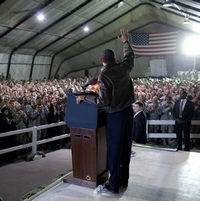President Barack Obama had multiple audiences in mind during his lightning 6-hour visit to Afghanistan this weekend. In both his meetings and his speech delivered to U.S. soldiers and broadcast worldwide, Obama wanted to catalyze improved Afghan government performance, reassure Afghan citizens, bolster U.S. troop morale, and make his commitment to winning the Afghan war clear to global audiences.
For security reasons, Obama departed unannounced from Washington on Saturday night, arriving at Bagram airfield, on the outskirts of Kabul, early Sunday evening. He then flew by helicopter to meet Afghan President Hamid Karzai. Afterwards, Obama returned to Bagram to address several thousand cheering U.S. troops and civilians. To gain additional perspectives on the Afghan situation, Obama also consulted with Gen. Stanley McChrystal, the commander of U.S. and Coalition forces in the country, and Karl Eikenberry, the U.S. ambassador to Afghanistan. He then returned to Washington aboard Air Force One early Monday morning.
Obama's trip to Afghanistan was only a surprise in tactical terms -- given the large U.S. troop presence in Afghanistan, it was just a matter of time before he visited the country. Indeed, the White House indicated that Obama had planned to come earlier, but had been thwarted by bad weather and other obstacles. The completion of the year-long congressional battle over health care, the postponement of Obama's planned trip to East Asia, and the imminent launch of perhaps the most important U.S. offensive to date in the Taliban stronghold of Kandahar province provided good reasons to make the trip now. Finally, it has been about one year since the Obama administration released its new Afghan strategy and almost four months after Obama's Dec. 1 speech at West Point announcing a major escalation in U.S. force deployments in Afghanistan. So it was time for the president to make an on-the-ground assessment of whether his approach has been achieving its benchmarks as well as whether any mid-course corrections were warranted.

